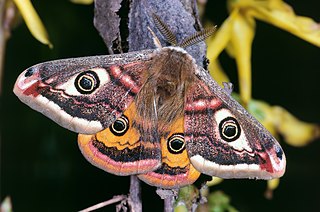
Saturniidae, members of which are commonly named the saturniids, is a family of Lepidoptera with an estimated 2,300 described species. The family contains some of the largest species of moths in the world. Notable members include the emperor moths, royal moths, and giant silk moths.

Gonimbrasia belina is a species of emperor moth which is native to the warmer parts of southern Africa. Its large edible caterpillar, known as the mopane worm, madora, amacimbi “pigeon moth” or masontja, feeds primarily but not exclusively on mopane tree leaves. Mopane worms are an important source of protein for many in the region. The species was first described by John O. Westwood in 1849.

Burkea africana, the wild syringa, is a deciduous, medium-sized, spreading, flat-topped tree which grows in the woodlands and savannas of sub-Saharan Africa. It is the sole species in genus Burkea, which belongs to the subfamily Caesalpinioideae of the family Fabaceae.

Eublemma is a genus of moths of the family Erebidae described by Jacob Hübner in 1829.

Colotis evagore, the desert orange tip, small orange tip, or tiny orange tip, is a butterfly of the family Pieridae. It is found in the dry parts of tropical Africa, northern Africa, southern Spain and southwest Arabia.

Colotis vesta, the veined tip, veined orange or veined golden Arab, is a butterfly of the family Pieridae. It is found in the Afrotropical realm.
Deudorix dinomenes, the orange playboy, is a butterfly of the family Lycaenidae. It is found in Senegal, Guinea, Sierra Leone, Ivory Coast, Ghana, Benin, Nigeria, Cameroon, the Central African Republic, the Democratic Republic of the Congo, Uganda, Sudan, Kenya, Tanzania, Malawi, Zambia, Zimbabwe, Mozambique and South Africa.
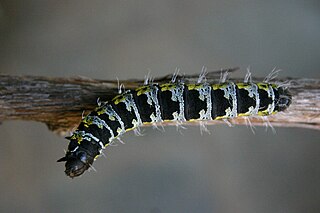
Cirina is a genus of moths in the family Saturniidae.

Stomphastis thraustica is a moth of the family Gracillariidae. It is known from Democratic Republic of Congo, Congo, Central African Republic, Ghana, Nigeria, Namibia, Zimbabwe, South Africa, Madagascar, Malaysia, Indonesia and India. It was recently also recorded from China.
Azygophleps albovittata is a moth in the family Cossidae. It is found in Nigeria, Ghana, Uganda, the Democratic Republic of the Congo, Kenya, Guinea and Zimbabwe.

Pardoxia graellsii, the yellow drab, is a moth species in the family Nolidae first described by Joachim François Philibert Feisthamel in 1837. It is found in France, Spain, Turkey, Iraq, China, India, Myanmar, Cape Verde, the Comoros, Ethiopia, Ghana, Réunion, Madagascar, Malawi, Mauritania, Mauritius, Nigeria, Saudi Arabia, Sierra Leone, South Africa, the Gambia, Yemen and Zimbabwe.

Amata alicia is a species of moth of the subfamily Arctiinae. It occurs throughout Africa, from Morocco to South Africa.
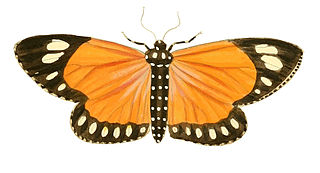
Scopula helcita is a moth of the family Geometridae first described by Carl Linnaeus in his 1763 Centuria Insectorum. It is found in Cameroon, the Republic of the Congo, the Democratic Republic of the Congo, Equatorial Guinea, Ghana, Nigeria, Sierra Leone, South Africa and Uganda.

Achaea finita, the finite achaea, is a moth in the family Erebidae. It is found in the Democratic Republic of the Congo, Eritrea, Ethiopia, Ghana, Kenya, Réunion, Madagascar, Mozambique, Nigeria, Rwanda, Sierra Leone, South Africa, Uganda, Zambia and Zimbabwe.
Micralarctia punctulatum is a moth of the family Erebidae. It was described by Hans Daniel Johan Wallengren in 1860. It is found in Angola, Botswana, Cameroon, the Democratic Republic of the Congo, Eritrea, Ethiopia, Ghana, Kenya, Malawi, Mozambique, Namibia, Niger, Nigeria, Senegal, South Africa, Tanzania, Gambia, Uganda, Zambia and Zimbabwe.

Maerua angolensis is a 10m tall, occasionally deciduous tree of the Capparaceae or caper family, often growing on termitaria and in thickets fringing seasonal watercourses, up to 1800m. Though never common, it is widespread in tropical Africa and arid regions, being absent from high-rainfall regions.
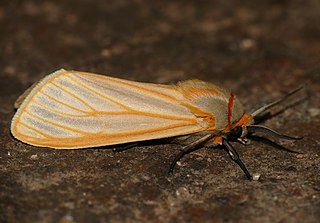
Afromurzinia lutescens is a moth in the family Erebidae. It was described by Francis Walker in 1855. It is found in Angola, Cameroon, the Democratic Republic of the Congo, Equatorial Guinea, Ethiopia, Ghana, Guinea, Guinea-Bissau, Kenya, Nigeria, Sierra Leone, Somalia, South Africa, Tanzania, Togo, Uganda and Zimbabwe.
Eulophonotus myrmeleon is a moth in the family Cossidae. It is found in Cameroon, the Republic of Congo, the Democratic Republic of Congo, Equatorial Guinea, Ethiopia, Ghana, Ivory Coast, Kenya, Mozambique, Namibia, Nigeria, Sierra Leone, South Africa, São Tomé & Principe, Togo, Uganda and Zimbabwe.
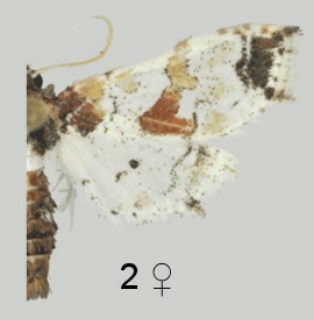
Leucinodes africensis is a species of moth in the family Crambidae. It is found in West Africa, Angola, the Democratic Republic of the Congo, Gabon and Tanzania. It has been intercepted with plant imports from Ghana and Zimbabwe to Great Britain and the Netherlands. The species was described by Richard Mally, Anastasia Korycinska, David J. L. Agassiz, Jayne Hall, Jennifer Hodgetts and Matthias Nuss in 2015.
Zebronia phenice is a moth in the family Crambidae. It was described by Stoll in 1782. It is found in Cameroon, Mayotte, the Democratic Republic of Congo, Equatorial Guinea, Ethiopia, Gabon, Ghana, Ivory Coast, Kenya, La Réunion, Madagascar, Mauritius, Mozambique, Nigeria, Senegal, Sierra Leone, South Africa, Tanzania, Gambia, Uganda, Zambia and Zimbabwe.















